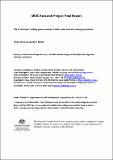| Abstract | The Upper Haughton Water Balance Study - Building grower capacity to understand and better manage groundwater commenced in July 2006 after growers expressed concerns at the rising groundwater table in the Burdekin River Irrigation Area (BRIA) and in particular the Upper Haughton sugar growing area (Figure 1). Several cane farmers approached BBIFMAC to develop a grower driven project to look at identifying and quantifying the groundwater rise in the area in order to raise awareness within the farming community of this issue. The lower Burdekin region is part of the dry tropics, characterised by a short intense wet season usually occurring from January to March, where two-thirds of its annual rainfall occurs (Petheram et al., 2006). The average annual rainfall for Ayr is approximately 1000mm but is highly variable, ranging from 100mm to nearly 2000mm. In recent years annual rainfall has exceeded the long term average for the area, with 1055mm in 2007, 1280mm in 2008 and 1653mm to October 2009. Almost all of the rain in 2009 fell from January to April with the remainder of the year being very dry. 2009 is currently the second wettest year on record for Ayr. The above average rainfall over the past 3 years has had a major influence on rising groundwater in the BRIA. Previous studies have shown that groundwater levels have remained relatively constant in the BRIA during dry years (since the area was opened to intensive irrigation in 1988), however in wetter than average years, groundwater levels have increased significantly (Petheram et al., 2006). Prior to intensive irrigation in the BRIA, groundwater levels would drop during dry years and rise in wet years. This indicates there has been a change in groundwater behaviour since excess water has been introduced to the system through farm irrigation and SunWater supply channels. From looking at DERM records for various bores across the BRIA, this theory is supported, with most bores showing an upward trend since the area was opened to intensive irrigation in the late 1980’s and early 1990’s (PPK, 2001). Results from the UHWB study have shown groundwater levels rising quickly and consistently, averaging 0.36m per year for the past two years. In some areas groundwater came to within 0.5m of the surface during the 2009 wet season. This poses numerous issues for landholders in this area, including lost production from water logging and the possibility of secondary salinisation in areas of poor water quality. This is currently only occurring in relatively small patches but if the rising trend is allowed to continue across the region, it could affect a much greater area and put the entire industry at risk, costing industry and landholders many millions of dollars and creating huge socio-economic problems. |

